Birds | Butterflies | Insects | Mammals
Below you will find an alphabetical list of many of the insects that you might commonly find in Irish hedgerows.
ANTS
We have 20 species of ants.They are all social and have colonies and may have more than one queen. The colonies are perennial,, a whole colony survives from year to year. Worker ants cannot fly so they must collect food on the ground. Male and female ants have wings when they hatch out as adults and on fine autumn evenings they fly from the nest in a swarm.. After mating the females fall to the ground and bite off their wings.
BEES (BUMBLE)
There are 19 species of bumblebees in Ireland. One of the solitary bees has only been found in Ireland at 2 sites, one of these near Wexford has been built on and the other is in an old sandpit near Skerries now also in danger of being built on. Solitary bees do not live in colonies and have no worker bees. The colonies are perennial, surviving from year to year. They are pollinators and can be introduced for that purpose in crop farming.

Red-tailed bumblebee
BEES (HONEY)

Leaf-cutter bee
BEES (SOLITARY)
There are over 70 species of these in Ireland. They look like small honeybees. Some solitary bees are can be seen very early feeding on dandelions and pussy willows. Others like hawkbits, knapweed, ragwort, umbellifers and blackberry. They also pollinate apple and raspberry blossom. The males and females emerge and mate. Then the female makes her nest, on a sunny banks where her burrow is 10 to 15 cm long, other species build in hollow stems or in pithed stems like bramble or elder. Leafcutter bees build their nests from discs of leaves, often cut from rose leaves.
BEETLES/WEEVILS
Beetles are the most successful of insect orders, adapted to a great variety of ecologiacl situations. They are successful because of the consevation of their body water.Their main characteristic is the modification of the first pair of wings into hard, horny wing-cases or ‘elytra’ which protect the membraneous second pair of wings which are folded flat under them.
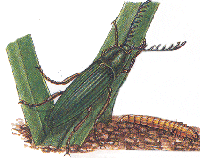
Click beetle or skip-jack

Cockchafer or Maybug

Devil’s coach horse or cocktail beetle

Earwig – Common

Green tortoise beetle

Nut Weevil

Rose chafer
BEETLES (BARK)
Beetles are the most successful of insect orders, adapted to a great variety of ecologiacl situations. They are successful because of the consevation of their body water.Their main characteristic is the modification of the first pair of wings into hard, horny wing-cases or ‘elytra’ which protect the membraneous second pair of wings which are folded flat under them.
BEETLE (COMMON WOODWORM Anobium punctatum)
They love a temperate climate such as in Ireland and are not found in the tropics. Called Common furniture beetle. Found in old hedges and inside houses in joists and floorboards particularly. It varies in length from 2.5 to 5.0mm and in colour from a light reddish-yellow through dark brown to red. Each wing-case has nine longitudinal rows of dark-coloured spots whichare in reality pits in the surface. Soon after mating, the female seeks egg-laying sites, such as crevices and wood joints.
BEETLE (ELM-BARK)
Has two generations a year. The female first bites out a mating chamber and after being fertilized, she makes another short (2 to 6 c,) but wide nursery tunnel along the edge of which she lays her eggs. The larvae then bite extensive tunnels, longer than the one made by their mother. The hibernating larvae produce the first generation in May. They first fly to the tree tops and feed on the new tender shoots.
LADYBIRD Coccinnellidae
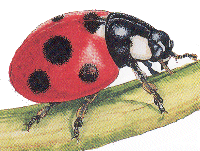
Seven-spot Ladybird
These are the best known beetles. They are very beneficial in the garden as they eat aphids, both as adults and larvae. The family Coccinnellidae had 3,500 species. The top surface is hemispherical whilst the undersurface is flat. The head is partly concealed beneath the prothorax and the last three segments of the antennae form a club. The legs are short and retractible beneath the body.
FLIES
It belongs to the family of flies SYRPHIDAE. It resembles wasps or bees and are attracted to flowers. It is about 15mm in length with the largest abdominal segment near the torax white and obvious, whilst the thorax and the rest of the abdomen is shiny black with some black bristles. The bases of the wings are bright orange. The males hover stationary in woodland whilst the females afe found sucking at flowers of bramble and dog rose for nectar.
CRANEFLY

Cranefly (black and yellow)
WHITE-BANDED DRONE FLY OR HOVER FLY Volucella pellucens

Broad-bodied libellula or Dragonfly
Male and Female
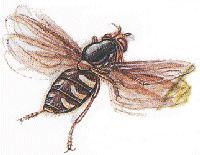
Horse fly

Mayfly
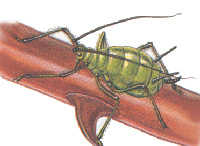
Rose aphid or greenfly
MOTHS
There are 538 different Irish moths. They belong to the new classification of the Lepidoptera where butterflies also belong. Death’s head hawk-moth Ii comes here as a migrant for the summer. It had a very thick body and is 0 cm wide with outstretched wings. It is a greyish brown colour on the forewings, the hindwings are yellow with two greyish-black band.
MOTH BRIMSTONE Opisthograptis luteolata

Brimstone moth (only found on Buckthorn hedges)
MOTH CHINESE-CHARACTER Cilix glaucata
Found in May, June and late July and August. It sits openly on a leaf but if disturbed, drops to the ground as if dead. The white forewings have a grey-brownish saddle-shaped mark. It has silvery scales on the veins. It is 20 mm wide when outstretched.
MOTH-HAWK
Death’s head hawk-moth Ii comes here as a migrant for the summer. It had a very thick body and is 0 cm wide with outstretched wings. It is a greyish brown colour on the forewings, the hindwings are yellow with two greyish-black band. It has a skull and crossbones pattern on the thorax.the caterpillar (larva) is a greenish brownish colour with white or lilac tubedrcles(rough ridges) and seven angled stripes.

hawk-moth Death’s head(rare)
It is moderately common, especially in boggy aeas where it feeds on willow, sallow, apple and crab, sometimes poplar and privet. The eggs are laid on a leaf, usually two of them. The caterpillar is greenish, covered with white ridges and with seven whitish stripes at an angle on its sides which are edged with green at the front.

hawk-moth Eyed (rare)
A finely marked, lemon-yellow moth found throughout Ireland. It is about 30mm with its wing-span, with rusty-red blotches along the front margins of the fore-wings and there is a small-ring-like mark in the centre of the front margin. The caterpillar resembles a twig, with bud-like projections on segments six and eight. It feeds mainly on hawthorn but also on sloes in blackthorn.
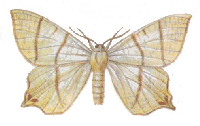
hawk-moth Swallow-tailed(rare)
MOTH-POPLAR HAWK Laothoe populi
A large moth which is common here. Its foodplants are poplar-Populus serotina, aspen,Populus tremula, willow and sallwo. The forewings and outer part of the hindwings are grey and brown and under the hindwings there is a brick-red spot. The eggs are big shiny green pearls, laid in May singly on leaves. When adult, the caterpillar is green wiyth yellowish ridges.. The seven angled stripes are yellow and its horn is green,tipped woth a reddish colour. There are usually two broods in the year.
MOTH-POPULAR LUTESTRING Tethea or subspecies Hibernica
It is found during June and July. It has pearly-grey forewings tinged with pink near the base, with a dark band with a jagged outline made of four black lines, the lutestrings. It measures about 35mm with outstretched wings. It is found where ther is aspen, in Donegal, Fermanagh, Sligo, Cavan, Mayo, Galway, Wicklow and Kerry.
SPIDERS
Spiders, scorpions, harbestmen, mites and ticks constitute the class Arachnida. They differ from insects as the body is divided into two main parts instead of three , as in insects. Arachne was the name of a maiden in mythology who was transformed into a spider by the goddess Athena. All spiders eat insects. They all have 8 legs. They have an abdomen, a waist (pedicle) and below that a cephalothroax.
SPIDER (CRAB Xysticus cristatus)
They run backwards and sideways in addition to forwards. They do not spin webs or chase prey but hunt by waiting in a good situation where insects may alight, frequently on a flower. They change colour like a chameleon in order to deceive the insect. Other species are coloured in browny shades and hide in dead leaves awaiting their prey.
SPIDER (OVAL BUSH Enoplognatha ovata)
Their lives are spent just a few feet above the ground on shrubs or in hedges. The web is simple with only a few criss-crossing threads, almost invisible. It spins a silk-lined shelter for itself amongst a few leaves fastened together with more silk and having access to the web. The length of the body is about 7mm, when resting. The eyes are raised on large tubercles and the legs are brown.
Wasps
They scavange for sweet food and also collect nectar. They have annual life cycles like bumblebees. An overwintered mated queen emerges on good days in April or may and start nest-building. Bees use wax for nest cells, wasps use paper made by chewing wood fibres collecte from posts. The nest is make of horizontal combs joined together by pillars. Young wasps are fed chewed up insects.
WASPS (GALL)
It lays its eggs in oak roots which as a protection against the larva, produce swelling or galls on the roots. The larvae feed on the tissue of the gall and in Spring tiny wingless female gall wasps emerge. They crawl up the tree and lay their eggs in the buds . The eggs are produced asexually as male gall wasps are not required to fertilize the eggs.
WASPS (SOLITARY)
There are 53 species in Ireland. They often nest on sunny banks like the solitary bees or can use hollow stems and rotting wood.. Inside the cells of the nest the female places food for her youngg, often insects or spiders which is stunned but not killed so it can stay fresh. Sjome species store aphids (greenflies, others leafhoppers, spiders, caterpillars and flies). An egg is put on top of the food store.
